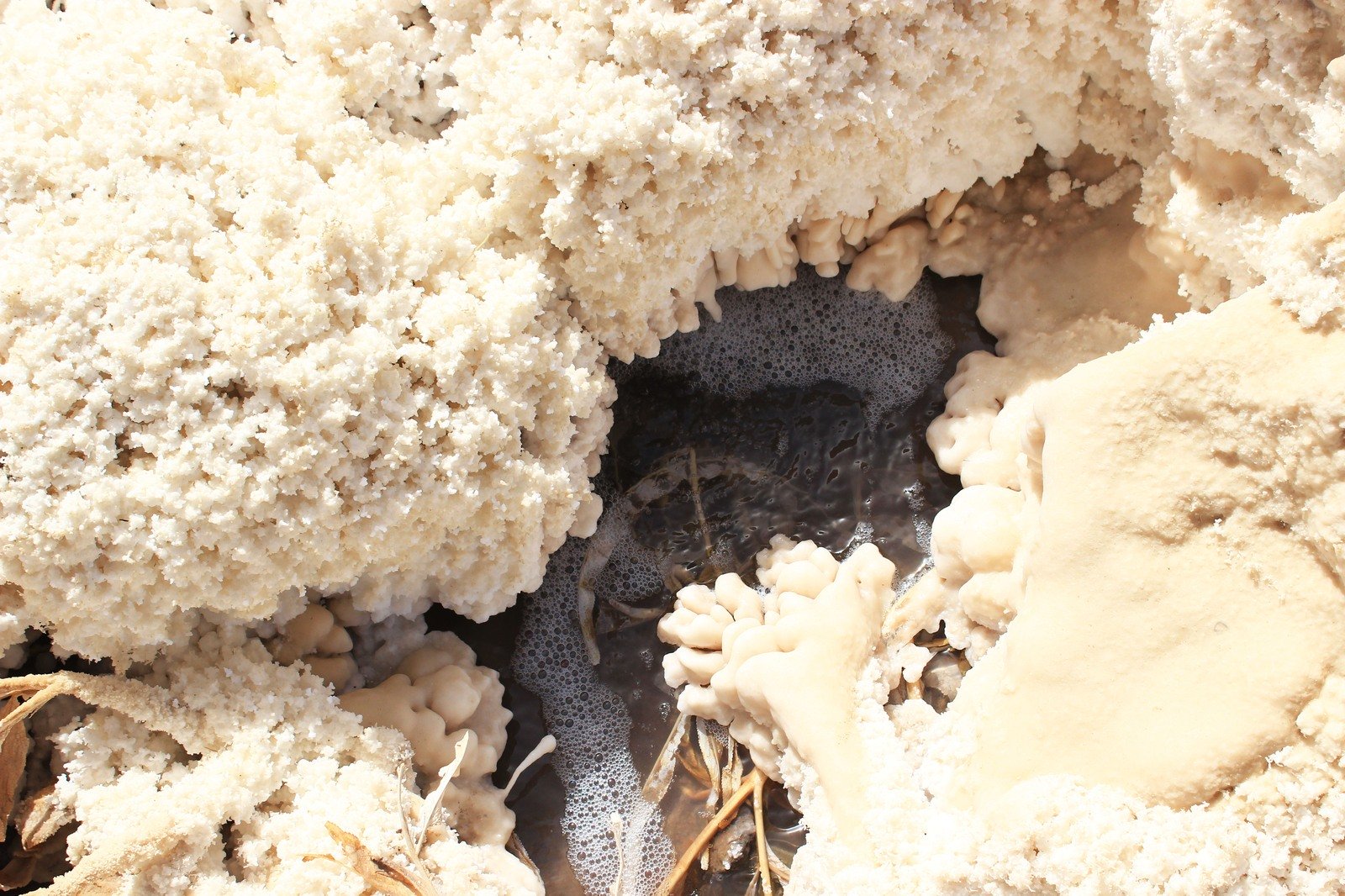You will travel for twelve days - there is the Taykan castle / a city on the way from Balkh to Badakhshan; There is a big grain market there. A glorious place, a high mountain of salt to the south, from everywhere for thirty miles around come for this best salt in the world. Salt is hard, they break it with large iron spades, and there is so much of it that it is enough for the whole world, until the end of the world.
- Books by Marco Polo
The local residents consider this place to be holy, and the water of the streams to be healing, thanks to which there are constantly sick people who are cured, often completely, by salt baths alone. Thick brine, settling on the bottom and surrounding rocks, covers everything with a white silvery coating, and salt crystals, sparkling in the sun, give a particularly beautiful look to this remote corner, which heals human ailments, probably from the most distant times of human existence in these places.
— D.N. Logothete
In Tajikistan, 174 kilometers from the Dushanbe, there is most remarkable mountain, its height is only 1332 meters, and it can be seen only from a few kilometers. What is its uniqueness? The fact is that this mountain is made of salt. If it were not for the thin "cap" of soil on its top, then one could say that it is 100% salt.
The mountain has a regular shape and resembles a mushroom cap with a stem sunk into the ground. Khoja-Mumin is extraordinarily beautiful in sunny weather. Salt on the slope’s shimmers is with a variety of bright colors. Dominant are bluish-green and pink tones.
WORLD RESERVE OF SODIUM CHLORIDE
There are more than 60 billion tons of salt at the base of the mountain alone. This stock would be enough for all mankind for several centuries.
FRESH WATER OVER THE SALT MOUNTAIN
With all this, a funny fact is that there are small fresh water reservoirs on the top of the mountain. If not for them, then vegetation would hardly have appeared here, but it is here and it is very beautiful. In spring, the mountain is covered with a bright red carpet of tulips growing here.
SALT CAVES
Another interesting feature is the large number of caves. For thousands of years, water flows from precipitation have washed wells and funnels in the mountain, forming a wide variety of passages inside. After the rains, salt streams form many salt streams that diverge in different directions. The caves consist entirely of salt stalactites and stalagmites. The height of the halls in the largest caves reaches 8-10 meters. The largest of the caves is almost 350 meters long (although there is an assumption that its length is more than a kilometer, but it is extremely difficult to verify this assumption, since the main passage is replete with narrow and flooded manholes). Many of the caves make music-like sounds created by wind passing through stalactites hanging from the ceiling and stalagmites growing from the bottom of the caves.
PRODUCTION AND TREATMENT
Since ancient times, local residents have been extracting salt from the slopes of the mountain. The Khoja Mumin table salt deposit is one of the largest in the world. At the foot of the plant, JSC "Khoja Mumin" was built, which is engaged in the production and processing of salt, providing enterprises and the population with salt, prevention of osmatic diseases on the basis of a dispensary.
ROUTE / OBJECTS: Dushanbe - Hulbuk Fortress - Khoja Mumin Salt Mountain
Route length: 348 km (from Dushanbe)
 Availability: February - November
Availability: February - November Direction: Dushanbe-Dangara-Vose
Direction: Dushanbe-Dangara-Vose Duration: 1 day (8 hours)
Duration: 1 day (8 hours)  Type of tour: individual, calculation for 2 (2-4 people), for Solo (1 person) +50%
Type of tour: individual, calculation for 2 (2-4 people), for Solo (1 person) +50%09:00 - the beginning of the tour, the reception of tourists from the hotel / place of temporary residence and direction to the side of the city of Kulyab
11:00 - arrival in the Vose region, visiting Khulbuk Fortress
HULBUK PALACE is an archaeological complex in the Khatlon region. It is located in Mehrobod village of Vose district. The complex occupies a hillfort with an area of 70 hectares, most of which is occupied by modern buildings. The structure of the settlement includes fragments of the settlement, a medieval fortress and its own palace. The settlement is identified with the ancient city of Khishtepa, the capital of the Khuttal (Khatlon) region in the state of the Ghaznavids. In the 9th-13th centuries Hulbuk was the residence of the governors. Probably the city was abandoned during the Mongol invasion. In the early 1950s, this site became of interest to archaeologists. Khishtepa (Brick Hill), as numerous pottery, glass, metal slag and even more bricks were scattered around it. During the excavations, which were carried out in the 1950-1960s, it was revealed that this place corresponds to the city of governors. More than 5 thousand artifacts have been found. To date, Hulbuk is a historical museum-reserve, which is spread over 16 hectares. There is also an art gallery on the territory of the museum.
13:00 - lunch, national cuisine
14:30 - arrival to the salt mountain Khoja-Mumin
Khoja-Mumin is extraordinarily beautiful in sunny weather. Salt on the slopes shimmers with a variety of bright colors. Dominant are bluish-green and pink tones. Only at the base of the mountain there are more than 60 billion tons of salt. This stock would be enough for all mankind for several centuries. For thousands of years, water flows from precipitation have washed wells and funnels in the mountain, forming a wide variety of passages inside.
16:00 - end of the excursion in Mount Khoja Mumin and return trip to Dushanbe
18:00 - arrival in Dushanbe, end of the tour
See you next time
